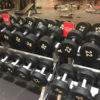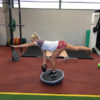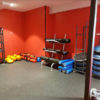Surf Fit News
Clive Rodell / personal trainer
For this article I thought I’d just break down some of the
terminology used in weight training and fitness training. Straight
forward for some, but not all. Enjoy. ?? I t could probably go on
much longer, but just some of the basics. This will help anyone to
understand training articles a little easier.
Glossary of terms;
Training; Anything that enhances current skill sets.
Resistance Training; Resisting a movement of limb and/or torso
Repetition; moving the limb or torso once or more
Repetition Max (R.M.) a movement done once or more to quantify
load, i.e. If you can lift a weight 2 x only (say 20kg) you have a
two R.M. for that movement of 20kg. Lifting capability once only of
24kg is a one R.M. of 24kg etc
Repetition range; a good way to quantify loads and a basis for load
variation, on any given day. Perhaps lift it 8-12 times, a rep
range of 8-12. If you cannot lift it eight times, too heavy, if you
can lift it more than 12 times too light.
Sets; A group of repetitions, for example lift 8 reps, take a rest,
lift again, take a rest, lift again and finish would be 3 sets of
8.
Optimal set number; Research generally says a minimum of 3 sets
(unless in the first month of training from scratch, then you would
build up to 3 sets etc.) and a maximum of 5 sets
Super-sets two or three exercises (generally) done one after each
other but not of the same muscle group. For instance, a Bench
Press, followed by a seated row. A super-set of 2 exercises, you
are resting from one, whilst performing the other, therefor
shortening the time of total exercise.
Ascending loads/sets each set is a little heavier than the one
before.
Descending sets/loads each set is lighter than the one before.
Drop down sets; performed immediately after the first set, but the
load drops. For example, Lat Pull down of 70 for 10, 50 for 10, 40
for 10, 30 for 10 then rest. Etc.
Pyramid sets; increasing load sets 1, 2, and 3, decreasing load 4
and 5.
Confusion sets; varying load and or reps in a hap-hazard fashion.
Used to promote change when some reaches a plateau in what they can
achieve.
Concentric Contraction, the muscle shortening under load (think
Bicep Curl up phase from straight arm to bent arm.
Eccentric Contraction, the muscle lengthening under load think from
bent to straight bicep curl (but NOT using gravity, descending
under control)
Eccentric training; heavier on the eccentric phase, as opposed to
the concentric phase. Think 25 kg Bicep curl up, 35kg down. Usually
done with help.
Tempo Training; Controlling the speed. Think Bicep Curl a count of
2 on the up, a count of 4 on the down. The eccentric phase in this
case takes twice as long. Also known as T.U.T. Time under tension)
Cheater sets; A heavier load but not in full range of motion, or
done with momentum, rather than controlled speed. Thus, not the
real load for the full-length capability of the muscle. If used
correctly, a technique to break plateaus or just plain bad training
technique for some, when they want to make you think they can lift
heavy!
Programme; the GPS of the training session or sessions.
Rest period; the time of rest between exercises.
Optimal training time (Resistance Training); usually 45 to 75mins
(some argue 90m) unless drug enhanced.
Core training; training techniques to enhance total core strength
(resisting movement/maintaining posture under load) NOT abdominal
work! (the abdominals are just but one component and should not (in
my opinion be emphasised)
Dumbbell; hand weight with centre handle and weighted ends.
Barbell; straight bar with added plates, or the capability of added
weight
Ezy curl bar; curved bar with an angular hold capability (some
people are not built to hold a straight bar)
Plate; weights that can be added to a bar.
Weight Stack; A column of weighted plates, usually selected by a
pin mechanism.
Cable machines; A clever pulley system to redirect gravity of a
load. Usually designed around a weight stack.
Attachment; usually used to describe a variety of handles, ropes,
bars that can be used on cable machines.
Bosu; A half ball type apparatus with a flat round top. Originally
designed for balance work, but funnily enough now marked….wait for
it…. Not designed for standing on. One presumes someone sued
someone.
Roller, Simple and ingenious and multipurpose log type device for
rolling and rolfing muscle and a variety of other useful
applications.
Kettle-bell; Basically, like a dumbbell with a better centre of
gravity for dynamic/ swinging exercises.
Cross-Trainer; Usually referring to an ‘Elliptical Trainer’, which
is a cross between a stepper and a bike.
Bike, Treadmill; Really? ??
C.V. Training; Cardio-Vascular Training, exercises that raise heart
rate, blood flow and respiratory (breathing) rate. Walking being
the obvious basic one.
Heart Rate; The beats of your heart measured per minute.
Maximum Heart Rate; The maximum your heart beats will go to (can be
raised slightly 3-6 beats by training, but is individual person to
person)
Resting Heart Rate; The true (unless fighting an illness) RHR is
taken over 5 days upon first waking (with no distractions).
Lactic Acid; A misnomer! Derived incorrectly from the fact Acidity
(PH) through exercise cannot be measured practically, so blood
lactate is measured as a close guide to acidity onset and rise in
the blood.
Lactate Threshold; The point where the Acid in the blood is too
great and cannot be buffered (Lactate) and causes pain and stoppage
of exercise. Runners ‘hitting the wall’ etc. We feel sick, a
natural mechanism, because the stomach is the only place where acid
can be discharged (throwing up).
Interval Training; Bouts of work/rest to help manage and raise the
ability to increase the tolerance of the above scenario.
Well! Phew! There are some definitions for you.
Merry Xmas and a Happy New year.
Clive Rodell.
Contact Clive directly






Recent Comments